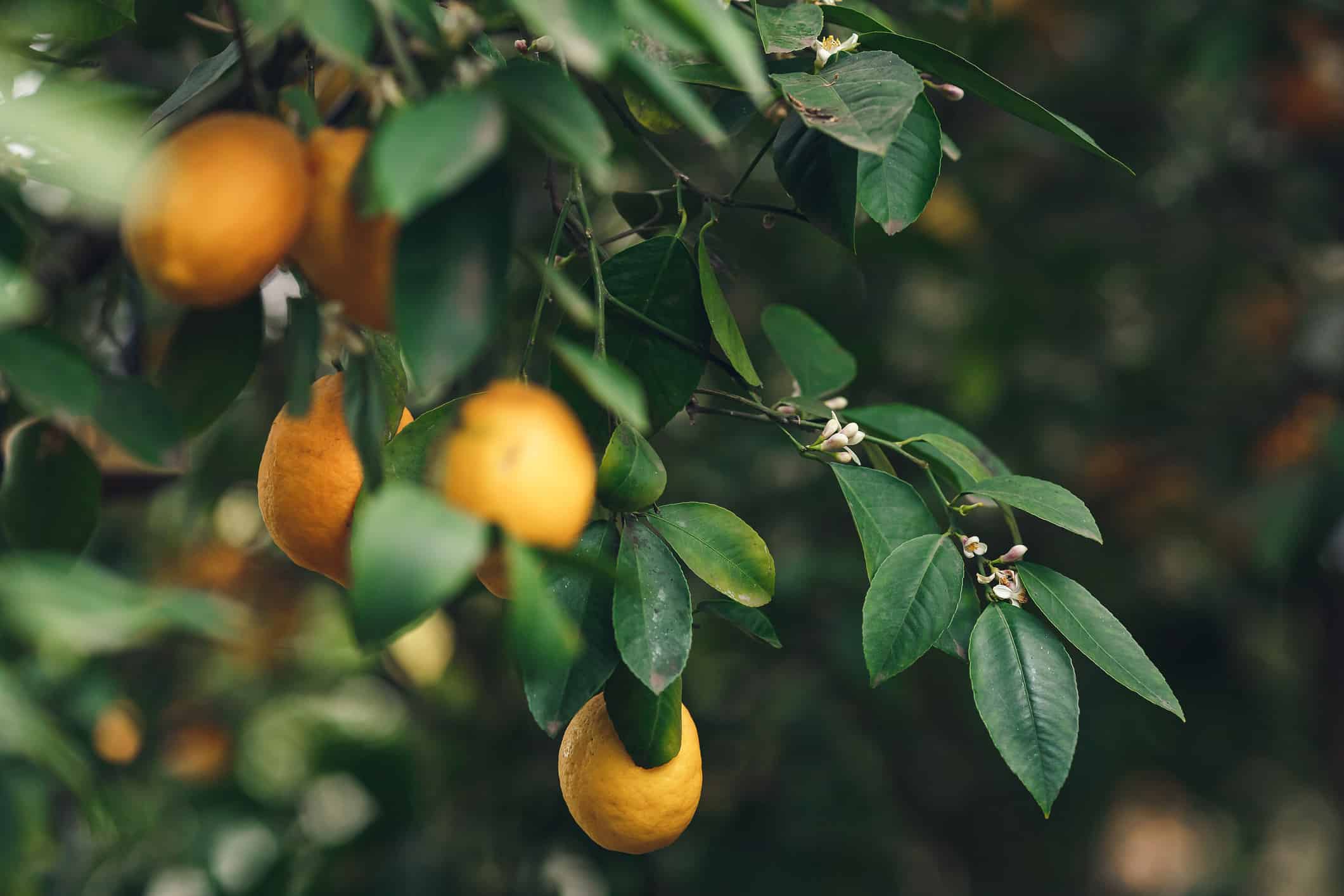In the colorful world of fruits, fruits that start with L often get overlooked. But don’t underestimate the delicious delights that this letter brings to our tables. From luscious and juicy to zesty and unique, fruits that start with L offer a tantalizing array of flavors and textures that are worth exploring. Let’s check out some of the best of the best!
1. Lemon

Lemons are subtropical, so they tend to do best in hardiness zones 9, 10, and 11.
©Claudio Divizia/Shutterstock.com
Lemon trees, scientifically known as Citrus limon, are renowned for their bright yellow fruits and versatile applications. These fruits that start with L serve a multitude of purposes in culinary, medicinal, and household contexts. Their tangy and sour juice enhances the flavor of various dishes, from salad dressings to cocktails. Lemon zest adds a zingy kick to baked goods and desserts, and their natural acidity makes them a valuable preservative, aiding in canning and pickling. Beyond the kitchen, lemon extracts and oil are utilized in cosmetics, perfumes, and cleaning products due to their invigorating scent and antimicrobial properties. In traditional medicine, lemons are praised for potential health benefits, such as aiding digestion and providing a vitamin C boost. Their flowers are also quite aesthetically pleasing.
Lemon trees thrive in subtropical to tropical climates, requiring well-draining soil and ample sunlight for optimal fruit production. They are sensitive to frost and cold temperatures, necessitating protection in regions where winter weather poses a threat. In such areas, lemon trees are often grown in containers or sheltered locations to safeguard against frost damage.
Several nations are particularly notable for their lemon production and exports. The United States, and more specifically the states of California and Florida, rank among the top producers of lemons in the world. In particular, Spain is a significant global supplier of lemons. In recent years, Argentina and India have emerged as formidable competitors in the worldwide lemon export industry.
2. Lime
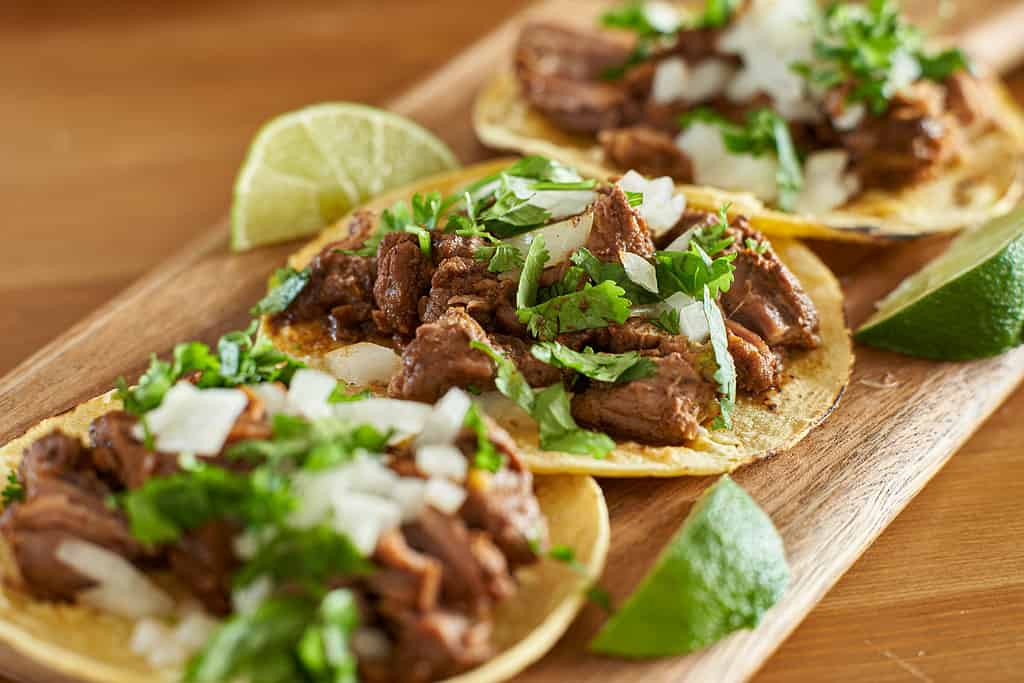
The lime is a staple ingredient in many Latin American cuisines.
©rez-art/iStock via Getty Images
Lime trees, scientifically known as Citrus aurantiifolia, produce small, green, and tangy fruits known as limes. Limes have a distinctive flavor that adds a zesty kick to a variety of culinary dishes and beverages. Salads, shellfish, and drinks all benefit from their acidic and refreshing flavor when lemon juice is added. The zest of a lime, which may be grated and utilized in cooking and baking to impart a burst of citrusy scent and taste, is another important component of marinades and sauces.
These trees thrive in warm and tropical environments. To provide high-quality fruit, they need well-drained soil, consistent watering, and lots of sunlight. Lime trees have a low tolerance for cold, thus they thrive in warmer climates. If you live in a colder area, you may bring your plants inside for the winter if you grow them in containers.
The biggest exporters of limes are primarily tropical countries with ideal growing conditions. The state of Veracruz in Mexico is a key manufacturing hub for lime, and Mexico as a whole is a prominent player in the worldwide lime industry. These nations benefit from the warm climates and suitable soil conditions that lime trees thrive in, allowing them to cultivate large quantities of limes for both domestic consumption and international export.
3. Lychee
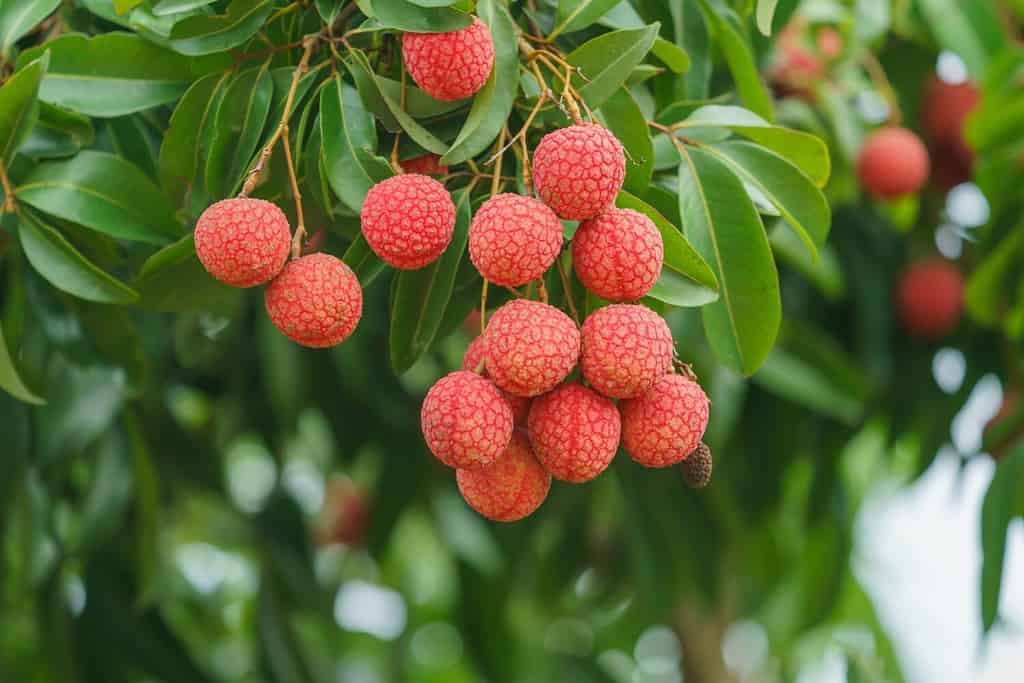
Lychee fruits thrive in USDA hardiness zones 10a through 11.
©Vietnam Stock Images/Shutterstock.com
Litchi chinensis, more often known as the lychee tree, has tiny, juicy fruits that are delicious and aromatic. The distinctive flavor and wide range of possible uses in cooking and medicine make these fruits highly prized. Lychees are at their most delicious when they are purchased fresh, peeled, and eaten immediately. Their sweet taste makes them a popular addition to many dishes, including fruit salads, desserts, and even cocktails. In addition to its use as a sweetener in Asian pastries and beverages, lychees are frequently included in savory dishes throughout the region. Lychee fruit has a high vitamin, antioxidant, and fiber content, making it a very valuable food source.
The lychee tree thrives in the warm, humid conditions typical of tropical and subtropical zones. For optimal fruit development, they need well-drained soil and lots of sunshine. These trees require a climate with moderate winters and sufficient rainfall because they are vulnerable to frost and drought. Lychee trees may be successfully cultivated in colder climates by being grown in pots and then transported inside before the onset of frost.
The majority of the world’s lychees come from China, where they are both grown and shipped. Guangdong, Fujian, and Guangxi, all located in the country’s south, are among the country’s most important lychee-producing provinces. A lot of lychees are grown and shipped out of other countries as well, including India, Thailand, and Vietnam. These nations benefit from the tropical climates and suitable growing conditions that lychee trees thrive in. The demand for lychees continues to grow globally, with exports reaching markets in North America, Europe, and beyond.
4. Longan
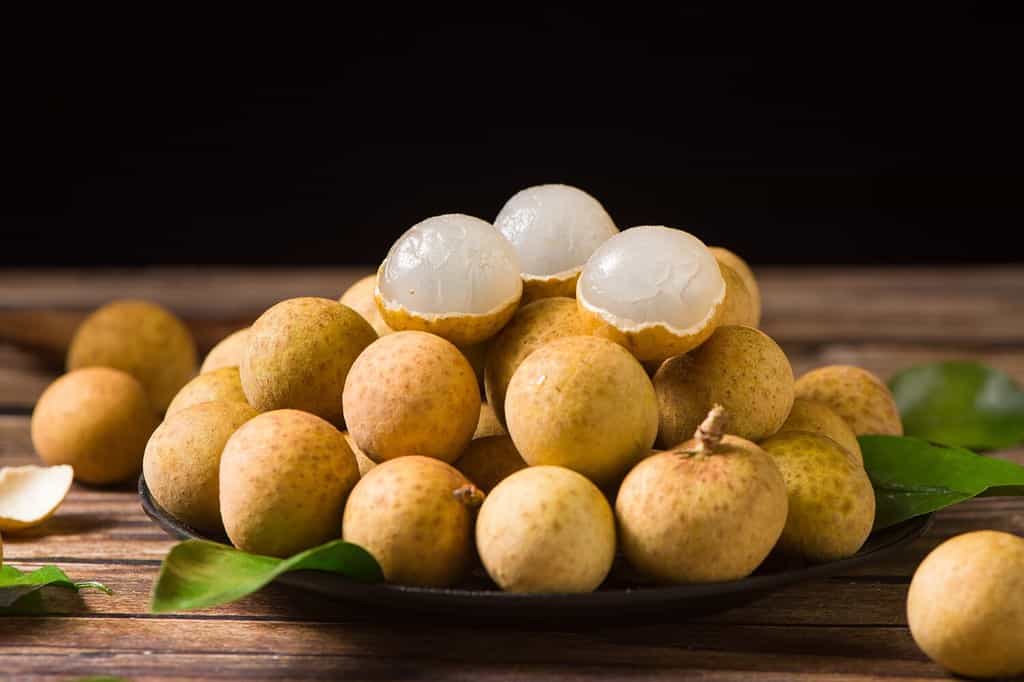
Longan fruits are often used to treat anemia, iron deficiencies, and skin problems.
©kungfu01/Shutterstock.com
The delicious and juicy flesh of the tropical fruit known as longan (or Dimocarpus longan) is highly prized. These little, spherical fruits are famous for their wonderful flavor and may be used in a wide variety of dishes. To cleanse your palate, try adding some longans to a fruit salad, or include them in sweets like puddings, sorbets, and preserves. They are also commonly used in Asian cooking, where their sugary taste complements savory ones in dishes like sweet soups, stir-fries, and curries.
Longan trees prefer warm, humid climates, therefore you’ll find them in the tropics and subtropics. For optimal fruit development, they need lots of sunshine and well-drained soil. Because of their susceptibility to cold and dryness, these trees are best grown in warmer, wetter climates. Longan trees may be grown in areas with colder winters by placing them in pots or greenhouses.
Thailand is one of the largest producers and exporters of longan fruit globally. Other significant longan-producing countries include China, Vietnam, and Indonesia. These countries benefit from their tropical climates and suitable growing conditions, allowing them to cultivate abundant quantities of longans. Longan exports primarily target international markets in North America, Europe, and Asia, where the demand for this sweet and exotic fruit continues to rise.
5. Loquat
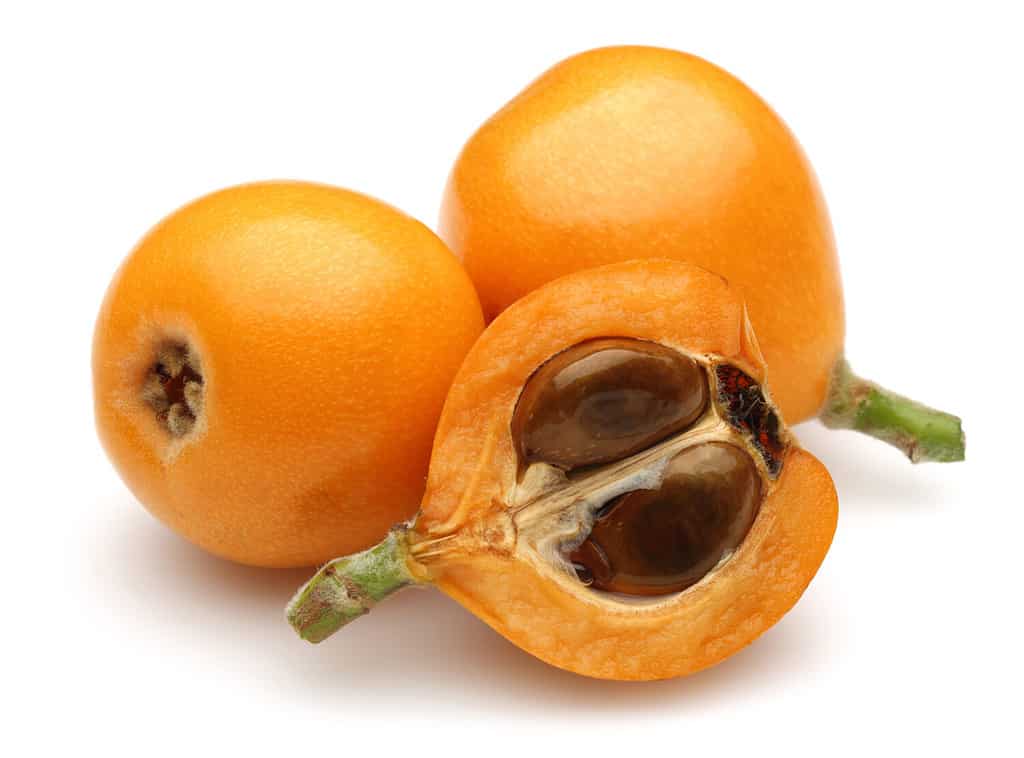
Loquat trees will fruit the best in hardiness zones 8, 9, and 10.
©mahirart/Shutterstock.com
You can’t have a list of fruits that start with L without the loquat! The loquat, also known as Eriobotrya japonica, is a small, yellowish-orange fruit. It is a delightful treat known for its sweet and slightly tangy taste. Native to southeastern China, the loquat has been appreciated for its delightful flavor and has since spread to various parts of the world. Many people make loquat syrup to aid in easing coughs, but it is also eaten raw.
The loquat tree thrives in mild, temperate climates. While it can handle cooler temperatures, it’s not a fan of harsh winters or extreme frosts. Because of its love for a warmer environment, places like California, parts of the Mediterranean, and other areas with a similar climate have become ideal spots for its cultivation.
When it comes to exports, countries in the Mediterranean region, particularly Spain and Turkey, are major players. They’ve been successful in growing large quantities of loquats and then shipping them worldwide. This makes it possible for people in various corners of the globe to enjoy this unique and tasty fruit. If you’ve never tried a loquat before, it’s worth seeking out; its unique flavor and juicy texture make it a favorite among many.
6. Lingonberry

Lingonberry jam is probably the most popular food to make with this tasty fruit.
©mariannehoy/iStock via Getty Images
Lingonberries (Vaccinium vitis-idaea) are vibrant red, small, and slightly tart fruits that have found a special place in many cuisines. These berries’ flavor is sometimes compared to that of cranberries, yet they stand on their own. Their acidic flavor is put to good use in a wide variety of drinks, syrups, and even sweets.
These berries have specific growing needs. They thrive in cooler climates and are commonly found in the wild in the boreal forests and Arctic tundra. It’s fascinating to know that lingonberries prefer acidic soils, often growing under pine trees which naturally acidify the ground around them. The cool, northern regions of countries like Sweden, Finland, and Canada provide the ideal environment for lingonberries to flourish. In these places, they are not just a fruit but a part of the cultural and culinary identity.
When we talk about the global market, it’s the Scandinavian countries that stand out in terms of lingonberry exports. Sweden, in particular, has been a dominant force, exporting these berries to various parts of the world. Their long-standing tradition of “everyman’s right,” which allows anyone to pick wild berries, has made the country a primary source of these delightful fruits. If you ever get the chance, tasting lingonberries, whether fresh or in a dish, is a flavorful experience that lingers in memory.
7. Loganberry
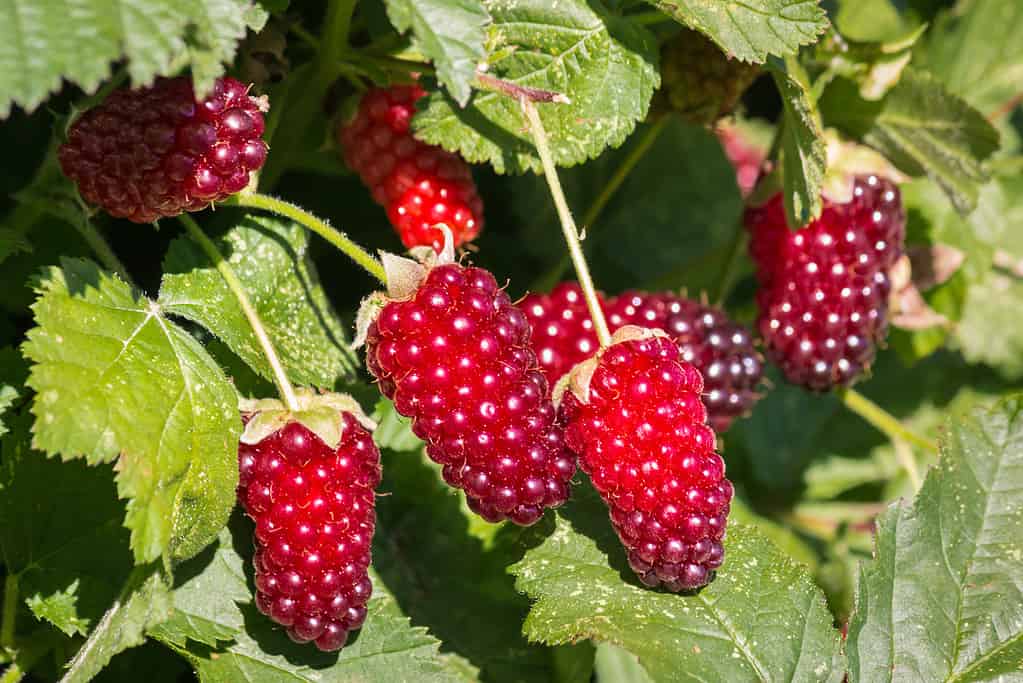
Loganberries grow well in hardiness zones 6 through 10, though they are not very hardy in colder regions.
©PatrikStedrak/iStock via Getty Images
These berries are another great member of fruits that start with L. Loganberries (Rubus × loganobaccus) are an interesting fruit, a delightful blend between raspberries and blackberries. These dark red, juicy berries have a unique taste, being slightly sharper than their parent fruits but just as delicious. They are often picked and enjoyed fresh from the bush, but that’s not the only way to savor them. Loganberries are popular in various culinary delights like pies, jams, jellies, and even wines. Their slightly tart flavor profile makes them a great addition to both sweet and savory dishes, providing a balanced and refreshing taste.
These berries have certain preferences when it comes to their environment. Loganberries love temperate climates where there’s enough sunlight and a moderate amount of rainfall. The plants are hardy and can endure cooler weather, but they flourish best in regions with mild winters. While they need well-draining soil, they also benefit from a little moisture, ensuring the berries remain plump and juicy. Gardeners often appreciate them for not only their fruit but also for their vibrant and spiky appearance which can be quite decorative.
On the global stage, loganberries might not be as widely recognized as strawberries or blueberries, but they still hold their own in certain regions. The Pacific Northwest, especially areas around Oregon, has been quite successful in cultivating and exporting these berries. Their distinctive flavor is sure to leave an impression.
8. Lulo
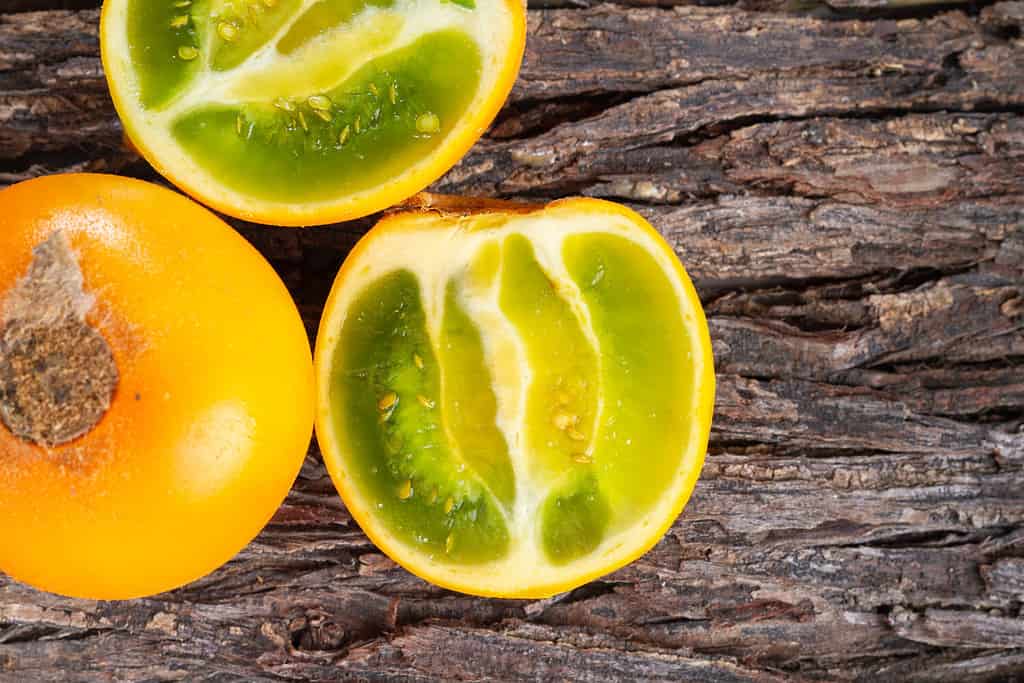
The lulo fruit is known for its unique taste. Depending on who you ask, it tastes like a combination of kiwi and pineapple, or rhubarb and limes.
©Alexander Ruiz Acevedo/Shutterstock.com
Lulo fruit or Solanum quitoense is a hidden gem often found in South America. At first glance, its bright green exterior may resemble a tomato, but its flavor is a delightful surprise. It has a zesty tang, similar to a mix of lime and pineapple, making it both refreshing and distinctive. People usually consume lulo fresh, but it’s also a popular ingredient in juices, smoothies, and desserts. In some regions, it’s even made into jams and sauces, introducing a unique twist to familiar dishes.
This fruit has a particular liking for specific environments. Lulo thrives in high-altitude, tropical regions, enjoying the coolness that these areas offer. It’s not a fan of harsh sun and prefers a bit of shade, which is why you’ll often find lulo plants tucked under taller trees in the wild. This fruit thrives on the rich, well-drained soils of mountainous regions in countries like Colombia and Ecuador.
Colombia is a major exporter and producer of this fruit. More and more people are discovering its deliciousness, driving up demand. Nowadays, you can find lulo in some international markets, especially those that cater to South American communities. While it’s still finding its footing on the global stage, those who’ve had the pleasure of tasting it often seek it out, charmed by its unique combination of tartness and sweetness.
9. Lebanese Wild Apples
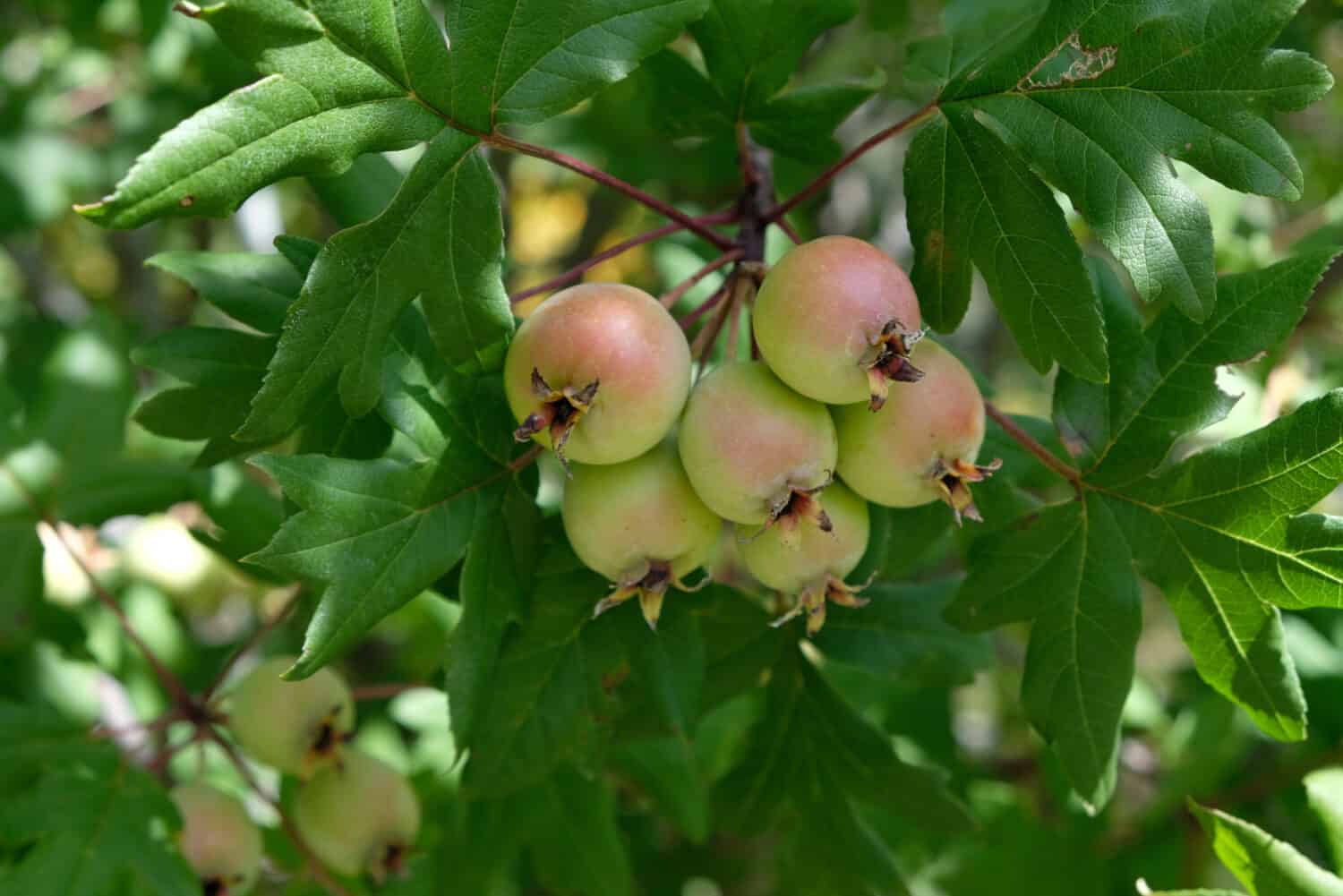
Lebanese wild apples are rare outside of Lebanon, but they can be found in international grocery stores and markets.
©Nita Corfe/Shutterstock.com
The last of our fruits that start with L is the Lebanese wild apple or Malus trilobata. It is a lesser-known gem among fruits. This apple type stands out from the ordinary apples you’d buy at a grocery shop because of its distinctive qualities. The fruit is smaller than average and has a flavor that is both sour and sweet, making it a delectable treat. It’s eaten fresh, but it’s also a favorite for making juices, jams, and even some local desserts. Its tangy punch brings a refreshing twist to many dishes.
Now, where does this apple prefer to grow? The Lebanese wild apple, as the name suggests, is native to Lebanon and some neighboring regions. It’s also adapted to the rocky and mountainous terrains of Lebanon, making it a hardy variety that can endure conditions many other apples might find challenging. The state of Veracruz in Mexico is a key manufacturing hub for lime, and Mexico as a whole is a prominent player in the worldwide lime industry. India, Brazil, and Thailand are all major exporters of lime. ng.
As for exports, the Lebanese wild apple isn’t as widespread in international markets as some of the more commercial apple varieties. However, Lebanon does export this unique fruit to some Middle Eastern and European countries where there’s a demand for exotic and traditional fruits. The charm of the Lebanese wild apple is gradually being recognized by more people, and its popularity is slowly on the rise.
Summary of Fruits That State with L + More
| # | Fruit |
|---|---|
| 1 | Lemon |
| 2 | Lime |
| 3 | Lychee |
| 4 | Longan |
| 5 | Loquat |
| 6 | Lingonberry |
| 7 | Loganberry |
| 8 | Lulo |
| 9 | Lebanese Wild Apple |
| 10 | Lechee Nut |
| 11 | Landsat |
| 12 | Limequat |
| 13 | Livistona Palm Fruit |
| 14 | Luna Nut |
| 15 | Lanzone |
| 16 | Lumat |
| 17 | Lotus Fruit |
| 18 | Lemonade Berry |
| 19 | Lillypilly |
| 20 | Leucaena Fruit |
Thank you for reading! Have some feedback for us? Contact the AZ Animals editorial team.

